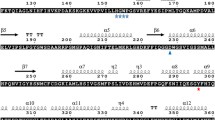Abstract
In a previous study, activity of the insect endocrine regulator juvenile hormone esterase (JHE), in the cricketGryllus assimilis, was subjected to bidirectional selection. This resulted in three pairs of high- and low-selected lines, each of which differed by 3.5-fold in JHE activity. In the present study, juvenile hormone esterases from these lines were characterized with respect to the Michaelis constant (K m), thermostability, and inhibition. None of three high-selected JHEs differed from its respective low-selected JHE in the Michaelis constant (K m) for juvenile hormone. Similarly, the high-selected JHEs did not differ from the low selected JHEs in thermostability or inhibition by either of two general esterase inhibitors (DFP, eserine) or a “JHE-specific” inhibitor (OTFP). Thus no evidence was obtained to suggest that the response to selection was due to allozymes or isozymes with altered kinetic or stability properties. Kinetic and stability properties were also very similar for the JHEs from the three high-selected or the three low-selected lines. Finally, none of the thermostability or inhibition profiles for any of the six JHEs exhibited sharp discontinuities, thus providing no evidence for the existence of multiple isozymes. The available evidence points to genetically variable regulators which affect the synthesis, degradation, or tissue distribution of JHE as being responsible for the divergence in JHE activity between the selected lines.
Similar content being viewed by others
References
Abdel-Aal, Y. A. I., and Hammock, B. D. (1985). Apparent multiple catalytic sites involved in the ester hydrolysis of juvenile hormones by the hemolymph and by an affinity-purified esterase fromManduca sexta Johannson (Lepidoptera: Sphingidae).Arch. Biochem. Biophys. 243206.
Baker, F. C., Tsai, L. W., Reuter, C., and Schooley, D. A. (1987).In vivo fluctuations of JH, JH acid, and ecdysteroid titer, and JH esterase activity, during development of fifth stadiumManduca sexta.Insect Biochem. 17989.
Duggleby, R. G. (1979). Experimental designs for estimating the kinetic parameters for enzyme-catalyzed reactions.J. Theor. Biol. 81671.
Fersht, A. R. (1985).Enzyme Structure and Mechanism W. H. Freeman, Reading, MA.
Graves, J. E., and Somero, G. N. (1983). Electrophoretic and functional enzymatic evolution in four eastern Pacific barracudas from different thermal environments.Evolution 3697.
Gu, X., and Zera, A. J. (1994). Developmental profiles and characteristics of hemolymph juvenile hormone esterase, general esterase and juvenile hormone binding in the cricket,Gryllus assimilis.Comp. Biochem. Physiol. 107B553.
Gu, X., and Zera, A. J. (1996). Quantitative genetics of juvenile hormone esterase, juvenile hormone binding and general esterase activity in the cricketGryllus assimilis.Heredity 76136.
Gupta, A. P. (ed.) (1990).Morphogenetic Hormones of Arthropods, Vols. 1–3 Rutgers University Press, New Brunswick, NJ.
Hall, J. G. (1985). Temperature-related kinetic differentiation of glucosephosphate isomerase alleloenzymes isolated from the blue mussel,Mytilus edulis.Biochem. Genet. 23705.
Hall, J. G., and Koehn, R. K. (1983). The evolution of catalytic efficiency and adaptive inference from steady-state kinetic data.Evol. Biol. 1653.
Hammock, B. D. (1985). Regulation of the juvenile hormone titer: Degradation.In Kerkut, G. A., and Gilbert, L. I. (eds.),Comprehensive Insect Physiology, Biochemistry and Pharmacology, Vol. 7 Pergamon Press, New York, pp. 431–472.
Hammock, B. D., and Sparks, T. C. (1977). A rapid assay for juvenile hormone esterase activity.Anal. Biochem. 82573.
Jones, G. (1995). Molecular mechanisms of action of juvenile hormone.Annu. Rev. Entomol. 40147.
Jones, G., Wing, K. D., Jones, D., and Hammock, B. D. (1981). The source and action of head factors regulating juvenile hormone esterase in larvae of the cabbage looper,Trichophusia ni.J. Insect Physiol. 2785.
Kerkut, G. A., and Gilbert, L. I. (eds.) (1985).Comprehensive Insect Biochemistry, Physiology and Pharmacology, Vols. 7 and 8. Endocrinology Pergamon, New York.
Leatherbarrow, R. J. (1987).Enzfitter. A Non-linear Regression Data Analysis Program for IBM PC (and True Compatibles) BioSoft, Cambridge, MA.
Linderman, R. J., Leazer, J., Venkatesh, K., and Roe, R. M. (1987). The inhibition of insect juvenile hormone esterase by trifluoromethylketones: Steric parameters at the active site.Pest. Biochem. Physiol. 29266.
McCaleb, D. C., and Kumaran, K. (1980). Control of juvenile hormone esterase activity inGalleria mellonella larvae.J. Insect Physiol. 26171.
Place, A. R., and Powers, D. A. (1979). Genetic variation and relative catalytic efficiencies: Lactate dehydrogenase-B allozymes ofFundulus heteroclitus.Proc. Natl. Acad. Sci. USA 762354.
Roe, R. M., and Venkatesh, K. (1990). Metabolism of juvenile hormones: Degradation and titer regulation. In Gupta, A. P. (ed.),Morphogenetic Hormones of Arthropods Rutgers University Press, New Brunswick, NJ, pp. 126–179.
Sokal, R. R., and Rohlf, F. J. (1989).Biometry 2nd ed., W. H. Freeman, San Francisco.
Zera, A. J., and Zhang, C. (1995). Direct and correlated responses to selection on hemolymph juvenile hormone esterase activity inGryllus assimilis.Genetics 1411125.
Zera, A. J., Gu, X., and Zeisset, M. (1992). Characterization of juvenile hormone esterase from genetically-determined wing morphs of the cricket,Gryllus rubens.Insect Biochem. Mol. Biol. 22829.
Zera, A. J., Koehn, R. K., and Hall, J. G. (1985). Allozymes and biochemical adaptation. In Kerkut, G. A., and Gilbert, L. I. (eds.),Comprehensive Insect Physiology, Biochemistry and Pharamcology, Vol. 10 Pergamon, Oxford, pp. 633–674.
Zera, A. J., Strambi, C., Tiebel, K. C., Strambi, A., and Rankin, M. A. (1989). Juvenile hormone and ecdysteroid titers during critical periods of wing morph determination inGryllus rubens.J. Insect Physiol. 35501.
Zera, A. J., Sall, J., and Schwartz, R. (1996). Artificial selection on JHE activity inGryllus assimilis: Nature of activity differences between lines and effect on JH binding and metabolism.Arch. Insect. Biochem. Physiol. 32421.
Author information
Authors and Affiliations
Rights and permissions
About this article
Cite this article
Zera, A.J., Zeisset, M. Biochemical characterization of juvenile hormone esterases from lines selected for high or low enzyme activity inGryllus assimilis . Biochem Genet 34, 421–435 (1996). https://doi.org/10.1007/BF00570123
Received:
Revised:
Issue Date:
DOI: https://doi.org/10.1007/BF00570123




